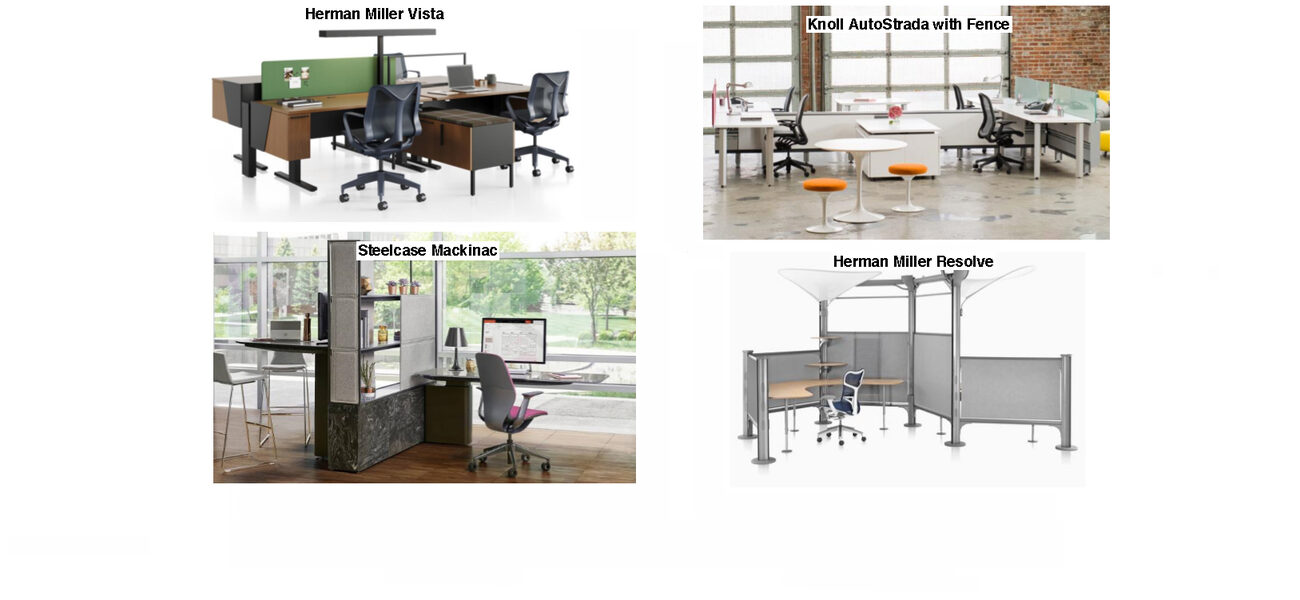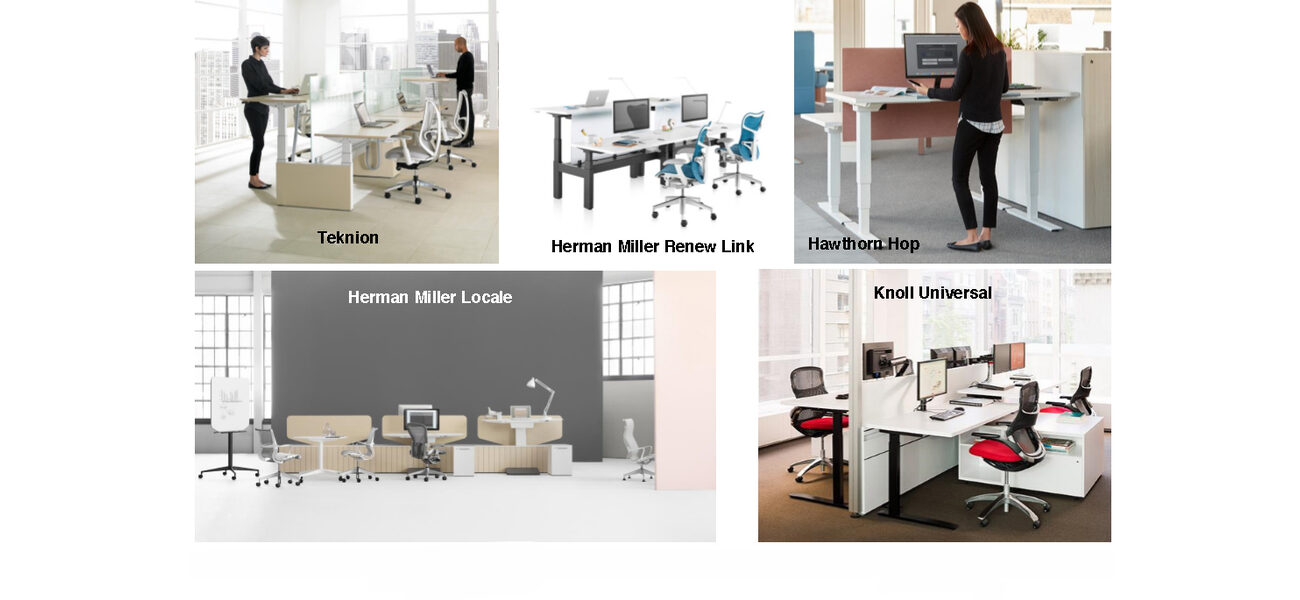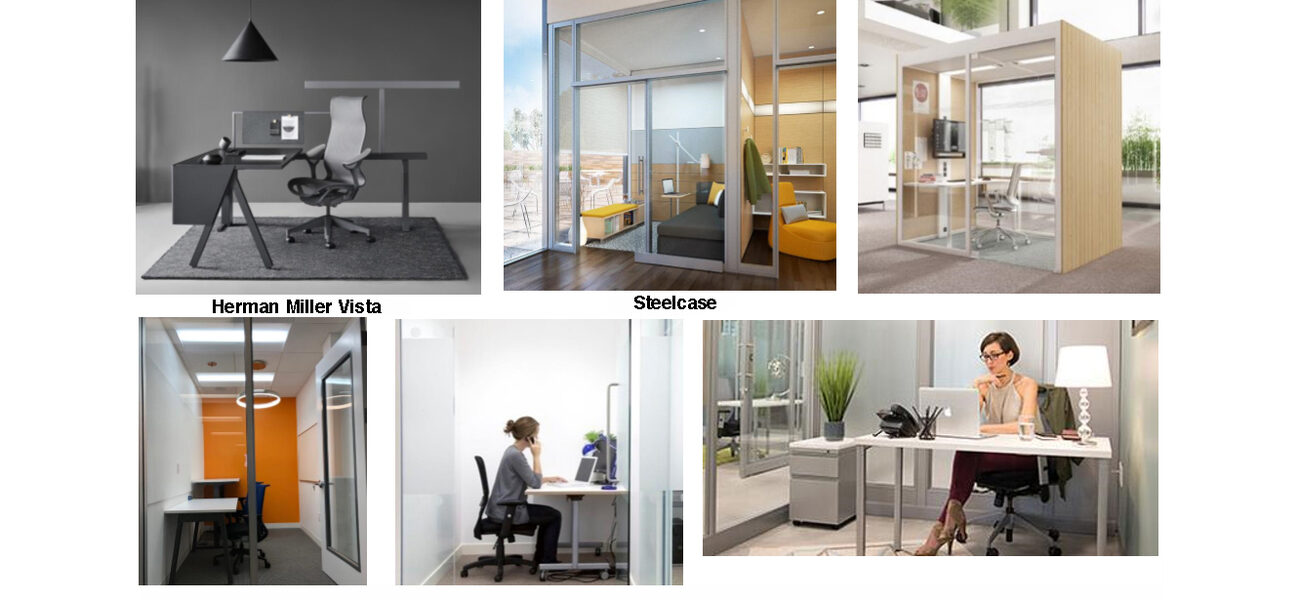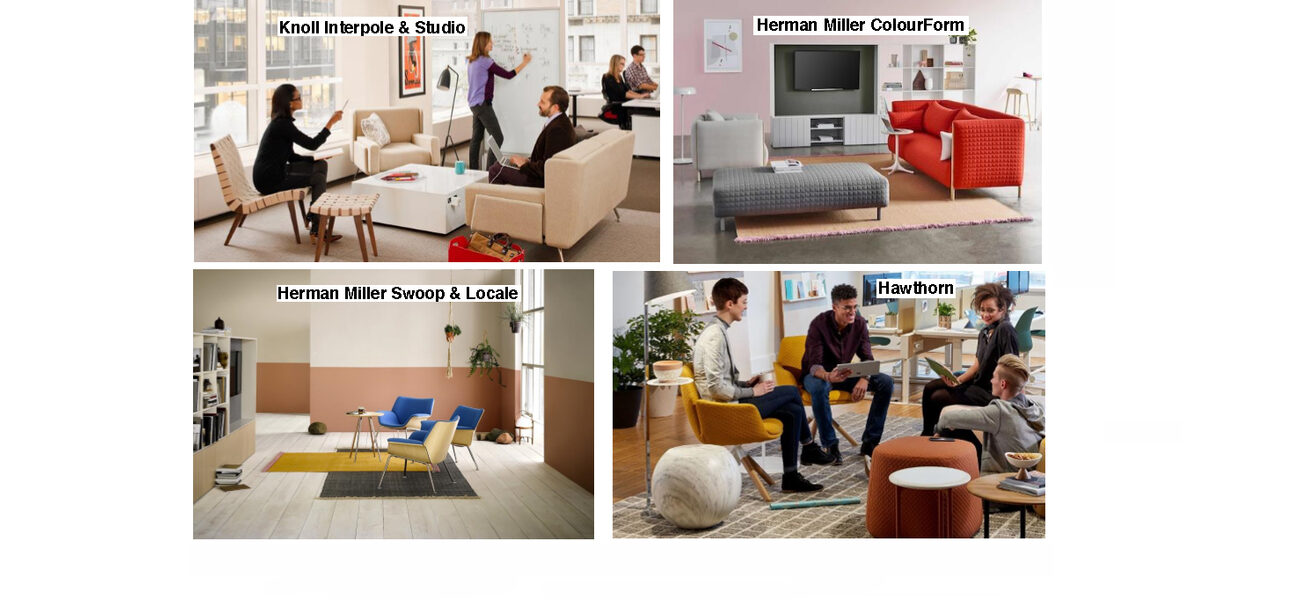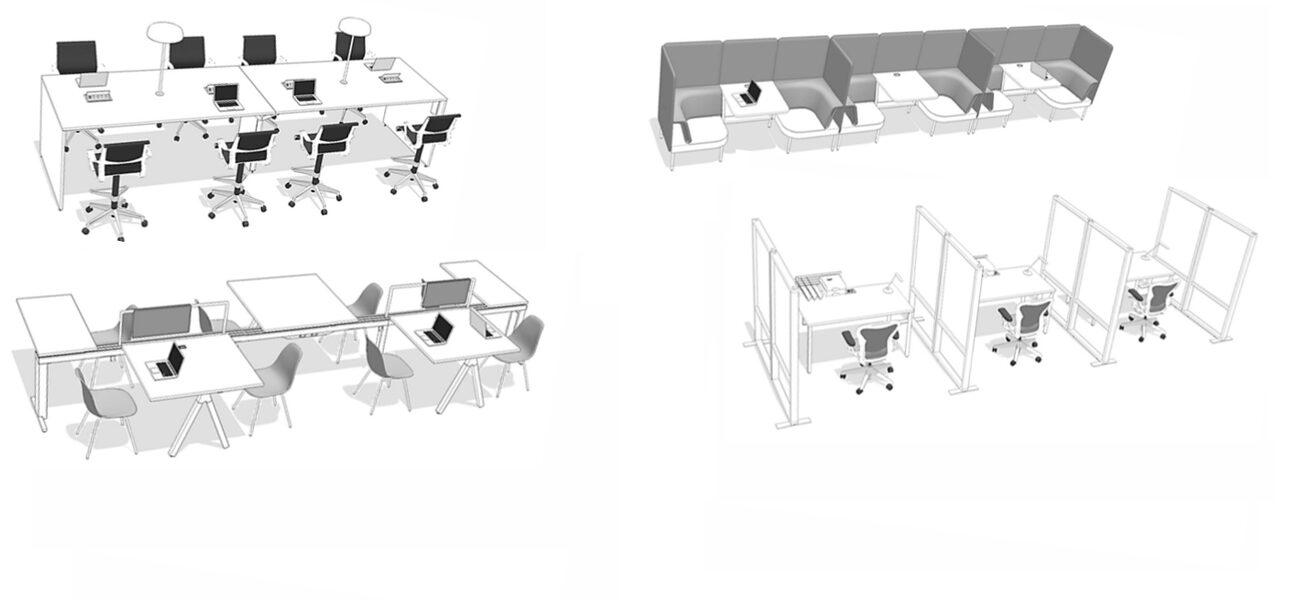As workplace environments continually change to accommodate the diversity of today’s employee workstyles, choosing the most appropriate furniture is an increasingly important aspect of the design process. While furniture selection may have been an afterthought in the past—a decision to be considered only after a building was constructed or renovated—many organizations now realize the value of putting furniture selection on the front burner. Furniture can impact workplace change initiatives by empowering employees, improving employee satisfaction and productivity, enhancing collaboration, and improving overall organizational efficiencies. The selection and placement of furniture—from standing desks, height-adjustable tables, room dividers, storage space, and myriad seating options—are now being aligned with an organization’s objectives.
“Selection is based on the type of workplace approach that an organization uses,” says Margaret Serrato, workplace strategist for AreaLogic, LLC, in Coral Gables, Fla. “It is no longer just about moving to an open environment. The secret is to have an environment that offers a wide variety of open and closed individual, group, and community spaces.”
Serrato describes three approaches: the established conventional workplace with the traditional mix of workstations/cubicles, offices, and conference rooms; the transitional workplace, which is essentially the conventional style with the ability to accommodate mobile workers; and the latest trend called the progressive, flex, or alternate workplace, which offers multiple types of work spaces to meet the needs of full-time, part-time, and remote employees who have varying needs.
The criteria for selecting furniture is similar regardless of the workplace approach, according to Serrato. Common factors to be considered include the size, location, and accessibility of the spaces where the furniture will be placed; ergonomics and comfort of building occupants; sustainability; and the need for enclosures, walls, private offices, technology connections, and storage.
Furnishing the Conventional Workplace
The oldest workplace model is the conventional setup, which traditionally featured private offices around the perimeter, workstations in the middle, and a few conference rooms. The more modern version includes the same components, but the workstation cubicles often are on the perimeter, and private offices are more centralized.
There has been a shift in private offices over the past 10 years, with a movement away from the large U-shaped desk with a big hutch containing lots of filing and storage space. Serrato notes that private offices and workstations assigned in the conventional workplace based on title and pay grade can still be large and have high to moderate enclosures for privacy and noise mitigation.
In general, offices are now smaller with a lighter footprint, simple furniture, less storage, and more transparency, with glass panels to facilitate a view inside the office and a single demountable wall, sometimes called a work wall. Height-adjustable loose desks and tables that can accommodate several people are meant to make the space inclusive by accommodating a variety of workers.
Large panel-heavy workstations with walls and overhead storage are giving way to less expensive, smaller, modular furniture with less enclosure and storage space. Large conference rooms with long board tables are being replaced with smaller gathering areas more suited for smaller meetings with casual seating and more support for technology and team activities.
“We are seeing more standing-height tables so that some people can be seated on stools and some can be standing at the table,” says Serrato. “The nice thing about this is that when you are standing to give a presentation, especially in a small room, you are still at eye-height with everyone else. This is beneficial for people who feel awkward standing up and talking.”
Moving to the Transitional Workplace
Since this workplace emerged to support a mobile and sometimes remote workforce, some of the more permanent, larger workstations may be replaced by drop-in or hot desks to support employees who are not always on site. When this trend began, the shared hot desks were segregated from the rest of the organization. At the same time, organizations were creating open collaborative spaces, equipped with technology, to accommodate teamwork and meetings for three to five people.
Serrato says it is important in the transitional workplace to be aware of how many people work at assigned cubicles or desks compared to the amount of open, informal collaborative space that is available. Collaborative spaces sometimes go unused, because workers stay in their assigned areas, and the collaborative spaces are uncomfortable, noisy, and don’t offer the necessary technology and support.
“We also saw a push for this kit-of-parts or seeing what is the smallest number of workstations that can be used to support different workstyles,” says Serrato. “The furniture for transitional workplaces, where some staff is unassigned and there are a few open meeting areas, has the same criteria as the furniture for the conventional workplace, except that the unassigned individual workstations usually are a bit smaller with less storage.”
The transitional workplace typically includes assigned workspaces for resident workers, such as support staff or administrative staff, who are always at their desks and require storage; space for flex workers, who are on site a lot but not always at their desk and do not require storage; and unassigned spaces for mobile workers. Workstations can be enclosed with panels that can be adjusted to provide both private and open environments, depending on employee needs.
Many corporations are using the resident/flex/mobile workstation model, while others offer touchdown space, rather than traditional workstations, for mobile workers. These touchdown areas offer a variety of seating and work arrangements in various locations, such as corridors, outside meeting rooms, or in break areas.
“When we started seeing lots of different settings, that was the beginning of the progressive workplace,” says Serrato. “The more variety corporations offered, the more the mobile people liked it because they could find what they liked best. They were no longer told they had to sit in one specific area; the idea of choice and control resonated with people.”
Shifting to the Progressive Workplace
Many transitional workplaces do not increase productivity and employee satisfaction because they are too open and noisy, says Serrato. Organizations are moving to the progressive or flex model, which is an activity-based workplace with a variety of seating in a mostly free-address, unassigned environment. Open, closed, and special seating choices provide options for individual, group, community, or client-specific needs.
The newer work environments provide an opportunity to use the most advanced technology, including power towers, under-carpet power tracks, power grommets on desktops, mobile screens and whiteboards, and a wide array of stools and chairs.
“These free-address, activity-based workplaces represent the future of work, and most clients that I work with are going this route,” says Serrato. “Complexity arises because there are many more types of settings, and since no one is assigned, personal storage is separated from individual workstations.”
The conversation has shifted from designing “rooms” to designing “settings,” which Serrato describes as rooms or areas with furniture and technology appropriate for the users’ expected work behaviors and activities. More than just an office or workstation, settings can have many different configurations of rooms, furniture, built-ins, and other amenities that support individual, group, and community activities.
Manufacturers such as Knoll, Herman Miller, and Steelcase design settings that help organizations achieve their business goals by enhancing efficiencies, productivity, and employee well-being. It is essential to establish the right mix of settings for an organization by determining how often people are at work and how much time they spend working alone and with others, rather than the conventional workplace model of using headcounts and growth factor to determine how many workstations were needed.
The progressive model includes many types of spaces to accommodate a variety of work:
Individual Open
Individual open space still consists primarily of a flex desk workstation for focused activities, but there are some variables. For example, the space is reservable, which gives employees a sense of control knowing where they are going to sit; it is away from the main circulation; spaced to reduce crowding; large enough for pair working; features ergonomically correct seating and an external monitor; and has height-adjustable furniture, access to utilities and technology, and personal lighting controls.
An alternative to the workstation is benching or desking, which is becoming increasingly popular. They are also reservable, situated away from the main circulation, spaced to reduce crowding, and include all of the same amenities as the flex desk workstation.
“The benching is nice when you have a few of them, but when you have 80 in a space together, it is very difficult for people to work,” cautions Serrato.
The height-adjustable desk is a major trend that emerged in the last few years as another option in the individual open spaces of the progressive model. It ensures the work surface is at a level that is comfortable to each employee who reserves and uses the desk, reducing neck, back, shoulder, and arm pain associated with furniture that is not ergonomically supportive.
Individual Closed
Individual closed space is highlighted by the flex office that supports solo, confidential work and provides the acoustical isolation necessary to facilitate concentration. It is designed for solo work, but enables a second person to sit and share the screen. These small offices have a variety of seating options and height-adjustable desks or tables.
Individual and Group Closed
This is a flex choice option that supports the common practice by mobile workers of alternating between working alone and meeting with others throughout the day. The reservation system ensures office availability and prevents concerns about where to store personal items for the day.
“The beauty of this space is you could think of it as your camping space for the day,” says Serrato. “You reserve it, you come in, you can work by yourself, you can have people come in for meetings, and you know that space is going to be there. The combination of it being reservable, plus it being a combination of a small private office and a small conference room, means you don’t need as many freestanding conference rooms. I have had a lot of success in facilities that have used this idea.”
Group Open
The group open meeting areas sometimes resemble a living room with soft seating options, including sofas and club chairs, to support varied postures; movable furniture; and tables for notebooks and refreshments. These areas, which support individual work and meetings with three to five people, cannot be reserved and are often noisy, because they are located near main circulation or work areas.
Acoustical furniture helps mitigate noise in these open environments. The free-standing, modular spaces usually have high backs and sometimes are equipped with power. Options include the Haworth Perimeter, Vitra Alcove, GlenEagle Meeting Pod, Verve Cave, SpaceWorx, and Herman Miller Prospect. A variation are booths and pods that are semi-enclosed with tops.
Freestanding furniture is also available to facilitate small meetings that require robust video-sharing technology. The Steelcase Mediascape, for example, features large video screens and a table to accommodate approximately five people.
Group Closed
The standard closed meeting room accommodates from five to 10 people, is located near the building entrance or on the main circulation path, can be simple for staff or more ornate for clients, features excellent video display technology and tabletop connections, includes chairs with no arms so they can easily slide under the table, and has a credenza for beverages.
“What has changed in conference rooms is the introduction of project rooms that we used to call war rooms,” says Serrato. “The hallmark of these rooms is the use of stool-height seating with tall tables. Everybody is at the same level and it makes it easier to watch a video or give a presentation. These rooms are replacing the standard boardrooms with long tables. These rooms feature mobile whiteboards, fixed tables for video, and small movable tables.”
Formal training and charrette rooms are increasing in popularity to support large groups for presentations and educational events. Typically, all of the furniture is mobile, with tables and chairs preferred, and an emphasis on the quality of the video display and sound system.
“One thing that works well in these rooms is to use different types of furniture to create a tiered effect,” says Serrato. “For example, you can have low chairs in the front, then training tables behind them, and tall tables in the back. This makes it a virtual tiered room, so it is easier for people to see.”
Completely enclosed freestanding pods with a top and doors can be used to support small groups in an otherwise open area, but Serrato says this type of furniture requires ventilation and lighting systems, making it expensive.
Community Open
The hub of the open space should be a centralized community area to support individual and group work in a relaxed atmosphere with nearby food service. This community space should be part of the main circulation, with freestanding furniture and banquettes along one side. Serrato suggests programming these into the design process and then planning the open and closed spaces around them, with the individual work areas on the perimeter.
Small landing areas—placed either outside the hub, near meeting rooms, or as a buffer between the main circulation and work areas—feature soft seating and a small amount of work space to support brief work and waiting periods before or after meetings.
Privacy pods and enclosed phone booths, both designed originally for conventional workplaces, are used in progressive spaces as another choice of where and how to work.
“While office furniture selection is a function of workplace type—whether it’s conventional, transitional, or progressive—the general trend is toward more variety, more mobility, and a lighter footprint,” says Serrato. “A lot of companies are moving to performance specifications rather than proprietary and reference specifications, by telling the manufacturer what they want and how much they can spend. It gives the manufacturer more creativity, gives the company more control over the budget, and allows the company to get better solutions.”
The focus is on innovation and quality, and the designer is spared the burden of creating typical workstation drawings.
By Tracy Carbasho
